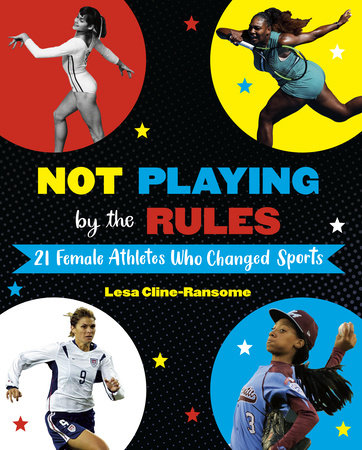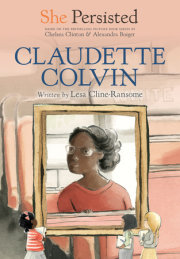Constance Applebee
Field Hockey
June 4, 1873–January 26, 1981
When Constance Applebee booked round-trip passage from England to America in 1901 to take a summer course at Harvard University, she never imagined it would be decades before she used her return ticket. But then Constance, a graduate of the British College of Physical Education, discovered that musical chairs and drop the handkerchief were the main sports offered for female students at American colleges. She took a stand.
“We play those games at parties,” she told her hosts. “For exercise, we play hockey.” Gathering up makeshift supplies and willing volunteers, Constance demonstrated the sport she played in her home country. One guest, Vassar athletic director Harriet Ballintine, insisted she demonstrate the sport at her school. From 1901 to 1902, Constance traveled with her equipment from Vassar to Smith to Wellesley to Mount Holyoke to Radcliffe to Bryn Mawr to teach female college students the sport of field hockey and the importance of physical activity. With each school she visited, the popularity of field hockey began to spread to women on college campuses throughout the country.
In 1904, she was hired to coach Bryn Mawr’s first field hockey team. As a coach, Constance demanded that her players exercise daily. Those who missed practice were required to pay a fine, which helped cover the cost of equipment, and she often shouted her signature insult from the sidelines: “Put your claws on your stick, you one-legged turnip!”
Instead of rebelling, her players adored her and insisted her methods made them stronger women. And it was Constance’s hope that their newfound strength in sports would translate into strength in fighting for women’s rights and in the voting booth.
In the 1920s, she founded the Sportswoman, the first magazine devoted entirely to women’s athletics, and opened a field hockey camp in Mount Pocono, Pennsylvania, serving one thousand girls taught by the best players and coaches from around the world.
She retired from coaching in 1929 but continued to advise teams and coach her players informally, playing on the fields until she was ninety-seven years old.
Lizzie Arlington
Baseball
1876 (?)–1917 (?)
A woman had to be strong if she wanted to play baseball in the 1800s. Bats weighed nearly three pounds, and a woman, clad in a heavy wool dress, had to hit the ball, drop the bat, drape her skirt over her arm, and run to first base. Most people agreed with major league pitcher Albert Spalding that baseball was just “too strenuous for womankind.” But Lizzie Arlington was one woman who disagreed.
Lizzie didn’t mind being the first. In the coal-mining town of Mahanoy City, Pennsylvania, Lizzie was the first girl to ride a bicycle. She loved to roller-skate. She competed in polo matches and was a pretty good shot with a rifle. Barely five feet tall and stocky, Lizzie didn’t exactly look like a baseball player, but her father and brothers taught her to hit, catch, and slide. Another local, future major league player John Elmer Stivetts, taught her to pitch.
On July 2, 1898, over fifty years after baseball rules were established, Lizzie suited up in a gray uniform with a knee-length skirt and black stockings, her hair tucked in a cap. She stepped on the pitcher’s mound for the Philadelphia Nationals reserve team as the first woman ever to sign a contract in the minor leagues, playing with all men.
Promoter William Conner became her manager, promising to pay her one hundred dollars per week. He hoped that a woman pitcher would draw thousands to the ball field, but when only five hundred showed, he cut Lizzie loose. Three days later, Lizzie signed herself for a second pitching spot with another minor league team, the Reading Coal Barons, and pitched a scoreless ninth inning. “Good for Lizzie!” shouted the one thousand fans who bought tickets, two hundred of them women.
Lizzie began barnstorming--traveling all over the country--with the all-female Bloomer Girls teams. “She is a success,” one sports reporter wrote, “for a woman.”
Ethelda Bleibtrey
Swimming
February 27, 1902–May 6, 1978
By the time the police arrived at Brooklyn’s Manhattan Beach, Ethelda was already waist-deep in the water. Handcuffed and led off to jail, seventeen-year-old Ethelda was charged with a criminal offense--removing her stockings to swim.
Since her very first dip in Saratoga Lake, little Ethelda loved the water. But her parents worried about her. She was sixteen when polio left her spine curved and her body weak. Her doctor suggested she start swimming to help her regain strength. She kept swimming to spend time in the water with her best friend, Charlotte Boyle. Ethelda not only got stronger, she got faster, leaving Charlotte behind time and again. When they swam at Manhattan Beach and the heavy wool from Ethelda’s swimsuit slowed her down, she peeled off her stockings, resulting in her arrest.
Ethelda continued to spend most of her time in water. She swam so hard and fast, she became the top swimmer in each of her amateur meets and caught the eye of coach Louis de Breda Handley, a former Olympian. He agreed to train her, and she won every race she swam. After only one year of competing, Ethelda raced Australian Olympic gold medalist Fanny Durack during her U.S. tour. She was the first woman to beat the champion. Coach Handley knew Ethelda was ready for deeper waters.
The only Olympic events for women in 1920 were tennis, diving, and swimming. Of the more than twenty-six hundred Olympians at the Summer Games in Antwerp, Belgium, sixty-three were women. Of these, twelve were Americans, and six of those twelve were on the swim team. With her best friend and fellow Olympic swimmer, Charlotte, by her side, Ethelda and the rest of the women’s swim team boarded a ship bound for Belgium.
The swimmers raced in estuaries with water so cold, they sprinted to the locker rooms to warm up after each finish. By the time the games ended, Ethelda had won three gold medals and set three world records. She was the first U.S. Olympian to win three golds and the only person ever to win all of the women’s swimming events. Still, Ethelda was disappointed. She could have won four gold medals, she said, “but they didn’t have women’s backstroke.”
Mildred Ella “Babe” Didrikson Zaharias
Golf
June 26, 1911–September 27, 1956
In the early-morning hours of June 26, 1911, an explosion on a barge reverberated through Hannah and Ole Didrikson’s neighborhood in Port Arthur, Texas, setting much of the town ablaze. Minutes later, their red-faced baby, Mildred Ella, hurried into the world.
Little Mildred caused a ruckus wherever she went. She lit matches between her siblings’ toes and beat up anyone who teased her. In school, she was told she was “too good to play with girls” and was put on boys’ sports teams. After hitting five home runs in one baseball game, she earned the nickname “Babe,” after major leaguer Babe Ruth.
“I came out here to beat everybody in sight, and that is what I am going to do,” she told her rivals before she competed in track and field, tennis, diving, bowling, and even billiards. After she joined her high school basketball team, the team went undefeated.
To help support her family, Babe accepted a job as a secretary for an insurance company that needed her talents on their company basketball team. She led the Golden Cyclones to the national championship for three straight years. In the off-season, her coach kept her busy with track-and-field events, and in 1931, she competed as the only member of her company track team at the National Women’s Amateur Athletic Union track meet. She single-handedly captured the championship title by winning first place in seven of the ten sporting events. And she scored second in an eighth. The next year, at age twenty-one, she qualified for the U.S. Olympic track team and won two gold medals and one silver, setting new world records in the javelin, 80-meter hurdles, and the high jump.
When asked by a reporter “Is there anything you don’t play?” Babe replied, “Yeah, dolls.”
After watching golfing great Bobby Jones during an exhibition, Babe decided she would experiment with the only sport she hadn’t tried. She practiced six days a week, sometimes sixteen hours a day, hitting fifteen hundred balls daily until her hands were bloodied and callused. Finally, she was ready to compete. Losing didn’t come easy to Babe, so after being narrowly defeated in her first amateur tournament in 1934, she won the next seventeen. She entered to compete in the 1938 Los Angeles Open, an all-male event.
Never afraid to tout her talents, Babe would ask at the start of tournaments, “Okay, Babe’s here! Now, who’s gonna finish second?”
Alice Coachman
Track and Field
November 9, 1923–July 14, 2014
No one could catch her. Not her brothers, not the neighborhood kids. No one. Her daddy told her to slow down, to act more ladylike, but Alice Coachman didn’t listen to her daddy. Or to anyone else who told her that being a girl meant she couldn’t play baseball and softball or run like the wind, barefoot down the red dirt roads of Albany, Georgia. When she wasn’t allowed to practice her high-jumping on the athletic fields with white people, Alice made her own bar by stringing together rags and attaching them to bamboo fishing poles.
Fred and Evelyn Coachman had ten children and they didn’t have time for a daughter who misbehaved, danced, and played sports when there was work to be done. But a teacher and an aunt, who both knew of Alice’s talent for sports, told her to keep right on competing. Alice showed everyone on her high school track-and-field team that you didn’t need shoes to break records when she earned herself a full scholarship to Tuskegee Institute. But free tuition meant that when Alice wasn’t practicing, studying, or winning national championships in the 100, 4 × 100 meter relay, and high jump, she had to earn her keep by maintaining the tennis courts, sewing football uniforms, and cleaning the gym.
Alice was ready to go to the Olympics in 1940, but because of World War II, the Olympics were canceled. Alice was ready to go to the Olympics in 1944, but again, because of the war, the Olympics were canceled. In 1948, on a rainy August afternoon in London’s Wembley Stadium, Alice cleared 5 feet, 61/8 inches and won the Olympic gold medal in the high jump, beating out Great Britain’s Dorothy Tyler. She was twenty-four years old, nearly six years older than most of her competitors.
When Alice sailed over the bar, she became the first African American woman to win an Olympic gold medal. But when she returned home to Albany, Georgia, for a hero’s reception, the local auditorium was segregated, the mayor refused to shake her hand, and she had to exit from the side door.
Still, Alice remained positive. “We had segregation, but it wasn’t any problem for me because I had won.”
Joy Johnson
Marathon Running
December 25, 1926–November 4, 2013
When Joy Johnson rose at four o’clock each morning, before she had her cup of coffee or laced up her sneakers, before she drove to the Willow Glen High school track in San Jose, California, she began the day with Bible verse Isaiah 40:31: “But they who wait for the Lord shall renew their strength; they shall mount up with wings like eagles; they shall run and not be weary; they shall walk and not faint.”
Joy had moved to California to escape the frigid midwestern winters of the Minnesota dairy farm where she grew up. She was a high school physical education teacher and track coach, but she never considered herself much of an athlete. That changed when she retired at age fifty-nine. Looking for ways to stay active, Joy began going for walks. But soon walking turned to jogging, one mile, two, and then three. She entered a local road race and then another and another. When her mantel filled with the trophies she won, a friend encouraged her to run the New York City Marathon.
“When I crossed that finish line in Central Park, I just knew this is what I would do the rest of my life,” she said. Joy made quilts from her race T‑shirts and sent postcards to her granddaughter Leah from New York City each year before she ran.
In 1989, she set the New York City Marathon record for a sixty-two-year-old. Ten years later, she ran her best time of three hours, fifty-five minutes, and thirty seconds. At eighty-one years old, when aging slowed her down, Joy attended marathon camp and changed her routine by increasing her weekly run totals from thirty to fifty-five miles. She shaved nearly one hour off her marathon time.
At age eighty-six, she promised her daughter that this, her twenty-fifth consecutive New York City Marathon, would be her last. “I’ll be at the back of the pack, but I don’t mind.” At mile twenty, Joy took a fall. Bandaged and bruised, she insisted on continuing the race and limped to the finish in nearly eight hours. The next afternoon after a TV interview, she returned to her hotel room to nap and never woke up.
Joy’s annual postcard to her granddaughter arrived at Leah’s dorm dated on the day of her death. She died in her running shoes, just as she always wanted.
Althea Gibson
Tennis
August 25, 1927–September 28, 2003
Daniel and Annie Bell Gibson got tired of scratching out a living as sharecroppers in the cotton fields of Silver, South Carolina, so they packed up their three-year-old daughter, Althea, and headed north to New York City, and a neighborhood called Harlem. Inside their home on 143rd Street, life was just as hard as in the South, but outdoors was altogether different. Baseball, basketball--Althea loved all sports, but in table tennis she couldn’t be beat. Long-legged and lightning-fast, Althea became a table tennis champion. When a mentor bought her a racket and invited her to a game of tennis on the Harlem River tennis courts, Althea found a sport she loved even better than all the rest.
Neighbors collected donations to pay for her membership and lessons at Harlem’s Cosmopolitan Tennis Club, where one year later she won her first local tournament. Throughout high school and college at Florida A&M, she won every championship in the all-black American Tennis Association events she entered, but her wins didn’t earn her any invitations from the white tennis organizations.
That is, until former tennis champion Alice Marble wrote an open letter to American Lawn Tennis magazine criticizing the discriminatory practices against Negro tennis players. One month later, Althea received an invitation from the U.S. National Lawn Tennis Association to play in the national championships at Forest Hills. Within two years she was a top ten player. With her strong, athletic style of play, reporters commented, “She hits the ball and plays like a man.” By 1953, she ranked number 7. By 1956, she ranked number 2.
She won in France, in Monaco, and in Italy. It was onto the finals. In less than one hour, Althea won the Ladies Singles’ championship in 1957, becoming the first black player to win Wimbledon.
She returned to a ticker tape parade, but it was coming home to Harlem that reminded her of how far she had come. “No matter what accomplishments you make, somebody helped you.”
Copyright © 2020 by Lesa Cline-Ransome. All rights reserved. No part of this excerpt may be reproduced or reprinted without permission in writing from the publisher.






